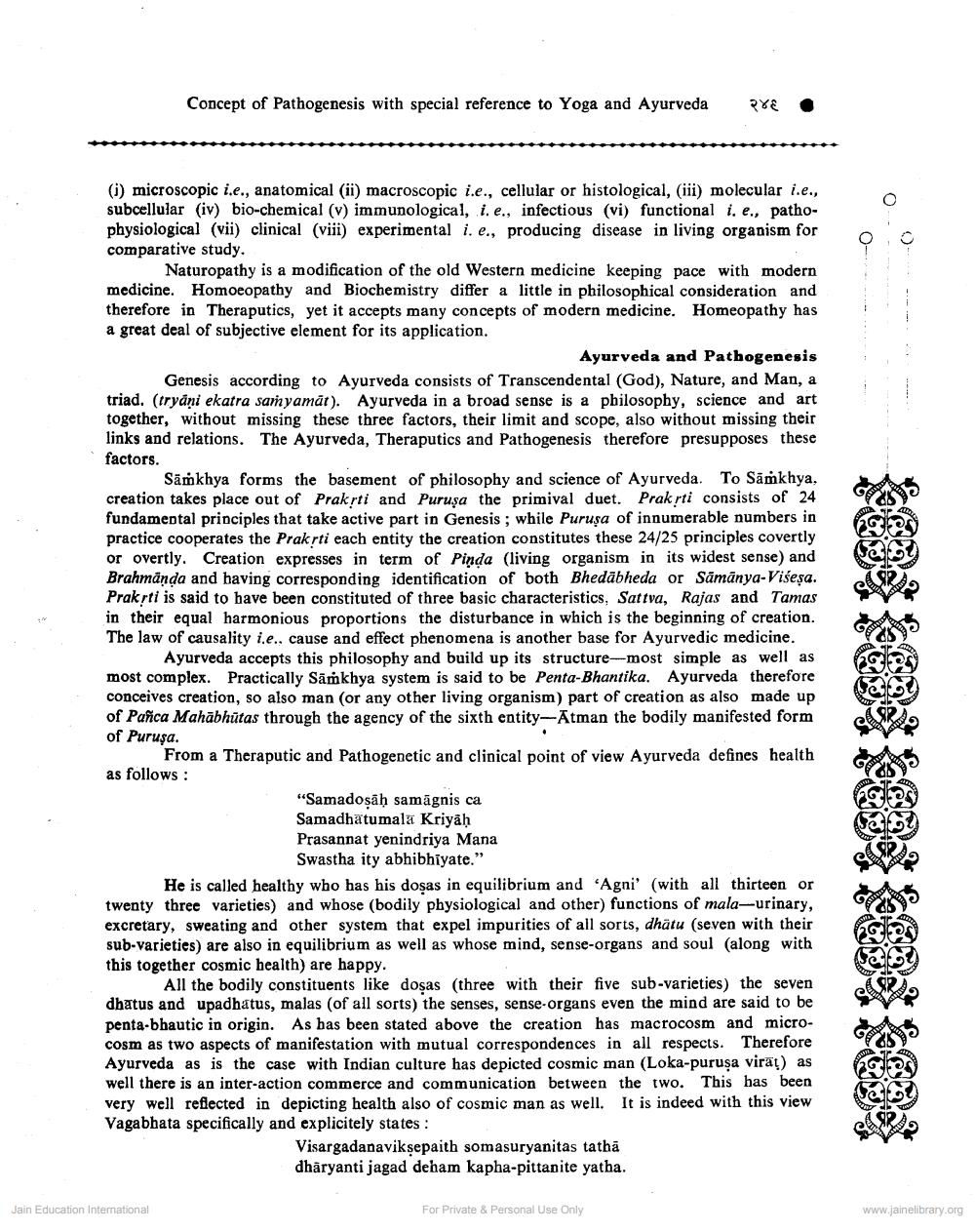Book Title: Concept of Pathogenesis with Special reference to Yoga and Ayurveda Author(s): S N Bhavsar Publisher: Z_Pushkarmuni_Abhinandan_Granth_012012.pdf View full book textPage 3
________________ Concept of Pathogenesis with special reference to Yoga and Ayurveda PXE • (i) microscopic i.e., anatomical (ii) macroscopic i.e., cellular or histological, (iii) molecular i.e., subcellular (iv) bio-chemical (v) immunological, i.e., infectious (vi) functional i, e., pathophysiological (vii) clinical (viii) experimental i. e., producing disease in living organism for comparative study. Naturopathy is a modification of the old Western medicine keeping pace with modern medicine. Homoeopathy and Biochemistry differ a little in philosophical consideration and therefore in Theraputics, yet it accepts many concepts of modern medicine. Homeopathy has a great deal of subjective element for its application. Ayurveda and Pathogenesis Genesis according to Ayurveda consists of Transcendental (God), Nature, and Man, a triad. (tryani ekatra samyamāt). Ayurveda in a broad sense is a philosophy, science and art together, without missing these three factors, their limit and scope, also without missing their links and relations. The Ayurveda, Theraputics and Pathogenesis therefore presupposes these factors. Samkhya forms the basement of philosophy and science of Ayurveda. To Samkhya. creation takes place out of Prakrti and Puruşa the primival duet. Prakrti consists of 24 fundamental principles that take active part in Genesis; while Puruşa of innumerable numbers in practice cooperates the Prakrti each entity the creation constitutes these 24/25 principles covertly or overtly. Creation expresses in term of Pinda (living organism in its widest sense) and Brahmanda and having corresponding identification of both Bhedābheda or Sāmānya-Višeşa. Prakrti is said to have been constituted of three basic characteristics, Sattva, Rajas and Tamas in their equal harmonious proportions the disturbance in which is the beginning of creation. The law of causality i.e.. cause and effect phenomena is another base for Ayurvedic medicine. Ayurveda accepts this philosophy and build up its structure-most simple as well as most complex. Practically Sāṁkhya system is said to be Penta-Bhantika. Ayurveda therefore conceives creation, so also man (or any other living organism) part of creation as also made up of Panca Mahābhūtas through the agency of the sixth entity- Ātman the bodily manifested form of Puruşa. From a Theraputic and Pathogenetic and clinical point of view Ayurveda defines health as follows: “Samadoṣaḥ samāgnis ca Samadhātumala Kriyāḥ Prasannat yenindriya Mana Swastha ity abhibhiyate." He is called healthy who has his dosas in equilibrium and 'Agni' (with all thirteen or twenty three varieties) and whose (bodily physiological and other) functions of mala-urinary, excretary, sweating and other system that expel impurities of all sorts, dhatu (seven with their sub-varieties) are also in equilibrium as well as whose mind, sense-organs and soul (along with this together cosmic health) are happy. All the bodily constituents like dosas (three with their five sub-varieties) the seven dhatus and upadhatus, malas (of all sorts) the senses, sense-organs even the mind are said to be penta-bhautic in origin. As bas been stated above the creation has macrocosm and microcosm as two aspects of manifestation with mutual correspondences in all respects. Therefore Ayurveda as is the case with Indian culture has depicted cosmic man (Loka-purusa virat) as well there is an inter-action commerce and communication between the two. This has been very well reflected in depicting health also of cosmic man as well. It is indeed with this view Vagabhata specifically and explicitely states: Visargadanaviksepaith somasuryanitas tathā dhāryanti jagad deham kapha-pittanite yatha. SS Jain Education International For Private & Personal Use Only www.jainelibrary.orgPage Navigation
1 2 3 4 5 6 7 8
